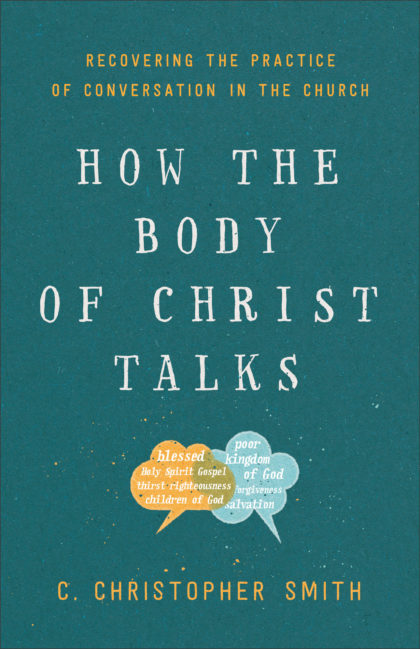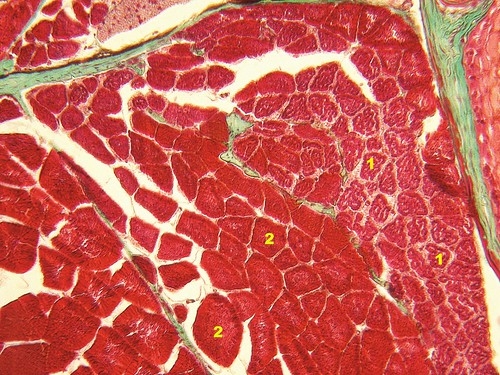
Given my interest in using contemporary science metaphorically, I could hardly pass up a book expanding on the church-as-body metaphor with human physiology and the practice of conversation. How the Body of Christ Talks by C. Christopher Smith is an invitation to deeper conversation for Christian congregations, although organizations of all sorts will likely find value in Smith’s observations and advice. He prefaces these with brief vignettes about how our physical bodies work, all motivated by a central premise that life is an ongoing conversation among our various cells. I appreciated the texture these analogies provided to the text, but for those wary of metaphors or of cell biology, rest assured that none overstay their welcome, quickly giving way to more explicit discussion of discussion.
Probably the strongest endorsement I can give How the Body of Christ Talks is that from very early on I was struck with a strong desire to be a part of a congregation seeking to apply what Smith describes. He regularly describes the practice of conversation at his own church, Englewood Christian Church in Indianapolis; it may have crossed my mind once or twice to wonder just how impractical (fairly) and awkward (very) it would be to relocate to Indiana to join them. They have been holding weekly conversation gatherings for over twenty years, apparently figuring how to make those functional and what benefits were obtained as they went along. Smith’s book is then essentially a compilation of lessons learned, supplemented with anecdotes from other congregations and a motivating theology.
The risk with such an approach is that what worked for Englewood may not work at your church. I cannot vouch for the book on the basis of having successfully applied it, but I do think Smith has done a reasonable job of being practical but not overly prescriptive and of incorporating principles and practices tested elsewhere. For example, chapter 4 outlines three formal, published conversational tools, each of which is particularly suited to facilitating particular types of conversations on specific sorts of topics within groups organized in different ways. These provide enough of a blueprint sketch for a church to implement without feeling overly constrained.
In spite of the generally practical bent to the book, where I was most disappointed was the lack of advice for anyone not a part of a congregation that has embraced the art of conversation. If your church is thinking about becoming more conversational, I expect the book would be a useful resource to read through (and discuss!) together. But if you found yourself persuaded by Smith’s call to dialogue and you are not a leader of a church, I suppose you can hand the book to your pastor and trust they will be persuaded as well. Relatedly, there are no resources for online conversations, an area which is apparently not of interest to Smith or requiring a separate treatment.

 )
)As Smith explores the practicalities of conversation, it is also interesting to see how the body metaphor blurs into actual application. The physiology of how our cells converse intrudes into the psychology of our discourse. This is perhaps most apparent in chapter 7, “Preparing Our Whole Selves for Conversation.” There Smith includes tips for embodied beings to consider how physical matters like rest influence how we relate to each other. Managing emotions is likewise a matter of the physical and the mental. This path from physiology to psychology eventually meanders into sociology as well, as successful conversations benefit from understanding group dynamics as well.
Here I am reminded of a comment from the BioLogos conference a few weeks ago. When organizing our thoughts about evolutionary natural history, we can use a small set of significant transitions as milestones. Each of these transitions involves individuals uniting into a collective. Examples include the transition from separately replicating genes to unified chromosomes and the transition from individual cells to multicellular organisms like us. I believe it was Jeff Schloss who noted that humans exist in a liminal place within such a transition. We have some capacity to organize into coherent, evolutionarily relevant social groups yet we have not allowed our individuality to be fully subsumed by group identities, not in the way that my individual cells have given over completely to being ‘me.’
And so we find the most critical point of divergence in Smith’s organizing metaphor. Our cells necessarily engage in constant conversation because they have no existence apart from it. Humans are more fundamentally individualistic, perhaps in a more pronounced way at present. This breakdown in the analogy is not a weakness of the book, however; this tension between our individualist nature and our need to be in community is front and center. Indeed, the clear and present need for remedial training in how to also be an ‘us’ and not just a ‘you and me’ motivates Smith’s writing. We may never resolve this tension, but we can certainly acknowledge that our neighbors aren’t going anywhere anytime soon, so we might as well get better at getting to know them better.
I requested and was provided a preprint manuscript for this review without further conditions from the publisher.
Andy has worn many hats in his life. He knows this is a dreadfully clichéd notion, but since it is also literally true he uses it anyway. Among his current metaphorical hats: husband of one wife, father of two teenagers, reader of science fiction and science fact, enthusiast of contemporary symphonic music, and chief science officer. Previous metaphorical hats include: comp bio postdoc, molecular biology grad student, InterVarsity chapter president (that one came with a literal hat), music store clerk, house painter, and mosquito trapper. Among his more unique literal hats: British bobby, captain’s hats (of varying levels of authenticity) of several specific vessels, a deerstalker from 221B Baker St, and a railroad engineer’s cap. His monthly Science in Review is drawn from his weekly Science Corner posts — Wednesdays, 8am (Eastern) on the Emerging Scholars Network Blog. His book Faith across the Multiverse is available from Hendrickson.

Leave a Reply